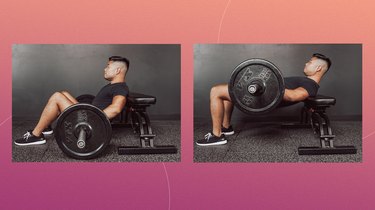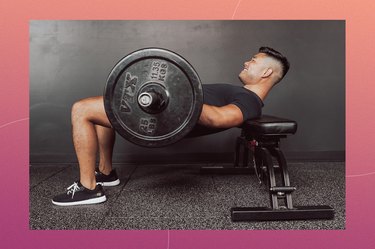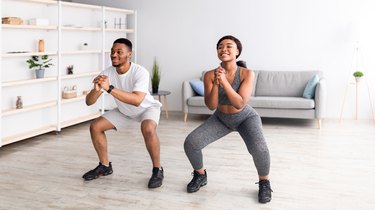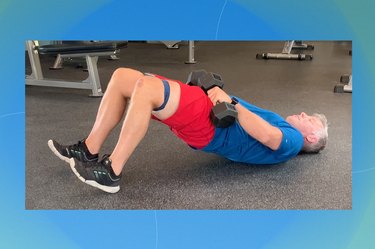


If you want to strengthen and build your glutes, then it's sort of a requirement to learn how to do hip thrusts. OK, you really shouldn't ever feel like you have to do an exercise, but the hip thrust (HT) is, hands-down, the single-best glute exercise of all time.
- What is a hip thrust? It's a lower-body exercise that involves sitting on the floor with your back against a bench, knees bent and feet flat on the floor, then extending your hips up toward the ceiling.
- What muscles does the hip thrust work? It isolates the glute muscles, focusing on the gluteus maximus, the largest muscle in the body.
- Who can do this exercise? It's safe for all ages and fitness levels. "Most individuals can master it in one simple training session because it requires less skill and is suitable for many body types," says Lisa Schroeder, CPT, a certified personal trainer at Life Time Chanhassen.
- Are hip thrusts as good as squats and deadlifts? Research actually suggests they are better at building your glutes than squats or deadlifts — more on that later. Compared with squats and deadlifts, HTs also require less core stability, coordination and spinal extension strength, so the general movement pattern is simpler to nail.
- Can you do a hip thrust at home? You've got options.You can do it using your body weight, or place a mini band above your knees to increase glute med and min activation. When you're ready to add more of a challenge, use a dumbbell or barbell.
Video of the Day
Related Reading
How to Do Barbell Hip Thrusts

Hip Thrust Form
- Sit on the floor next to a loaded barbell with your mid back against the edge of a bench or box.
- Place your feet on the floor about hip-width apart. Your feet can be slightly turned out, depending on what feels comfortable for you.
- Place some sort of pad (towel, squat sponge, Hampton thick bar pad, Airex pad) on top of your pelvis. You can also place a barbell sleeve around the bar, so you don't have to worry about anything shifting.
- Roll the barbell onto the crease of your hips.
- Squeeze your glutes and push through your heels to raise your hips and the weight up toward the ceiling. Keep your back flat and head pointed toward the wall in front of you.
- Lock your hips out at the top of the movement by fully extending the hips and squeezing your glutes. Your shins should be vertical, knees neutral or slightly externally rotated and legs forming 90-degree angles.
- Pause, then slowly lower your hips down to return to the starting position.
8 Hip Thrust Form Tips
Having the proper setup and hip thrust form is key to putting your glutes in the driver's seat and getting the most out of this exercise. Follow these tips, in order, to learn how to do hip thrusts most effectively.
1. Use Rubber Plates
To most easily set up for the HT, it's critical to have your barbell loaded with rubber weight plates. These soft, round weight plates are much larger than traditional metal ones. When using rubber plates, the barbell stays high off the floor. This lets you set up with your body under the bar.
Always secure your weight plates with clips.
2. Make Sure the Bench Hits Your Mid Back
Find a bench that comes to your middle back when sitting down on the floor. If you're using a tall bench, sit on a pad or some mats to raise your body.
If your bench is too high on your back, you won't be able to get as much leverage through your hips, says Jason Pak, CPT, a certified personal trainer, USA Weightlifting–certified sports performance coach and co-owner of Achieve Fitness Boston.
3. Play With Foot Placement
Done with ideal form, the HT is a glute isolation exercise. But foot placement has a large effect on which muscles you actually work.
Most people feel the greatest glute burn when their feet are set up so that, at the top of the move, their shins are perfectly vertical and perpendicular to the floor, Schroeder says. However, some people feel more glute recruitment with their feet closer to or farther from the hips.
Golden rule: If you feel your hamstrings working harder than your glutes, bring your heels closer to your hips. If your quads are in overdrive, move your heels an inch or so farther from your hips.
Keep adjusting until you find the position that lets you best isolate your glutes. That's the set-up you'll want to use going forward.
4. Drive Through Your Heels Into the Floor
Pressing through your heels, rather than your forefoot or toes, is another great way to engage your glutes, Schroeder says. Focus on keeping your heels glued to the floor throughout the entire exercise. (You can lift your toes up a little bit if it helps keep you honest.)
Then, to start each rep and drive those hips up, push your heels powerfully into the floor.
5. Tuck Your Tailbone
Keep your tailbone tucked and back flat during the exercise, Pak says. This helps you focus on your glutes and keep your lower back from taking over. It also reduces the likelihood of lower back discomfort.
As you lower your hips with each rep, think about teetering your back against the bench and avoid the temptation to curve your back around its edge.
6. Look Forward
Your neck plays a role in helping you keep a flat back, he says. So instead of letting your head fall back in line with the bench, keep your chin slightly lowered toward your chest. Throughout the entire exercise, keep your eyes locked on the wall in front of you and your head will naturally stay in place.
7. Lock Out Your Hips
The lockout position at the top is where you're going to get maximal glute gains, so it's important you nail this part.
To help you achieve full lockout, give your glutes a final extra squeeze at the top, Schroeder says.
8. Move With Control
Doing this exercise at a constant, steady pace helps ensure you're really firing up those glutes and not using any momentum.
"It can be helpful to slow down and count a tempo for the movement: 2 to 3 seconds up and 2 to 3 seconds down," Schroeder says. "Creating tension and metabolic stress in your glutes is the whole purpose of doing a barbell hip thrust. By lowering the weight too quickly, you are losing time under tension and activation in the glutes."
Related Reading
2 Modifications to Make HTs Easier
Move 1: Dumbbell
- Sit on the floor with your mid back against the edge of a bench or box and rest a dumbbell on top of your hips, holding it with both hands.
- Squeeze your glutes and push through your heels to raise your hips and the weight up toward the ceiling.
- Pause, then slowly lower your hips down to return to the starting position.
When learning how to do hip thrusts, starting with a dumbbell can help. You can either hold a single weight (as pictured) or two weights, with one on each hip, Schroeder says.
Move 2: Resistance Band
- Sit on the floor with your mid back against the edge of a bench or box. Anchor the ends of a resistance band to a dumbbell on the floor on each side so the band rests on top of your hips. Extend your arms out to the sides and lay them on the bench.
- Squeeze your glutes and push through your heels to raise your hips up toward the ceiling.
- Pause, then slowly lower your hips down to return to the starting position.
This banded HT is a great way to teach your muscles how to do a hip thrust with proper form. It's also a fitting variation if you don't want to hold anything in your hands or find resting a weight on top of your hips to be uncomfortable.
Adding a band to the HT creates more resistance at the top of the movement (when your hips are fully extended), enhancing this move's glute-building effects, Pak explains.
2 Progressions to Make HTs Harder
Move 1: Isometric Hold
- Sit on the floor with your mid back against the edge of a bench or box and rest a barbell on top of your hips, holding it with both hands.
- Squeeze your glutes and push through your heels to raise your hips and the weight up toward the ceiling.
- Pause for a few seconds, then slowly lower your hips down to return to the starting position.
Pausing at the top of the movement keeps your glutes under tension for a longer period of time. This promotes greater muscle growth.
Move 2: 1.5 HT
- Sit on the floor with your mid back against the edge of a bench or box and rest a barbell on top of your hips, holding it with both hands.
- Squeeze your glutes and push through your heels to raise your hips and the weight up toward the ceiling.
- Lower your hips halfway down and then press them back up to full extension before completely lowering them back down to the starting position.
Just like the barbell isometric hold, this partial-rep progression sets your glutes on fire by extending the time they're under tension.
- Journal of Applied Biomechanics: "A Comparison of Gluteus Maximus, Biceps Femoris, and Vastus Lateralis Electromyographic Activity in the Back Squat and Barbell Hip Thrust Exercises"
- Journal of Strength and Conditioning Research: "Electromyographic Comparison of Barbell Deadlift, Hex Bar Deadlift, and Hip Thrust Exercises: A Cross-Over Study


